
The Komondor, also known as the Hungarian sheepdog, is a large, white-coloured Hungarian breed of livestock guardian dog with a long, corded coat.
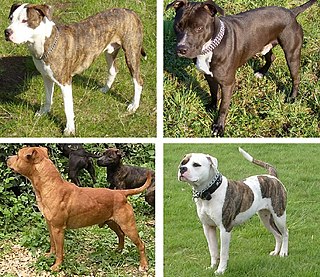
Pit bull is an umbrella term for several types of dog believed to have descended from bull and terriers. In the United states, the term is usually considered to include the American Pit Bull Terrier, American Staffordshire Terrier, American Bully, Staffordshire Bull Terrier, and sometimes the American Bulldog, along with any crossbred dog that shares certain physical characteristics with these breeds. In other countries, including the United Kingdom, the term is used as an abbreviation of the American Pit Bull Terrier breed specifically, while the Staffordshire Bull Terrier is not considered a pit bull. Most pit bull-type dogs descend from the British bull and terrier, a 19th-century dog-fighting type developed from crosses between the Old English Bulldog and the Old English Terrier.
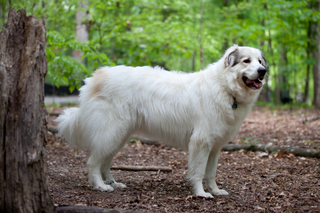
The Pyrenean Mountain Dog or Chien de Montagne des Pyrénées is a French breed of livestock guardian dog; in France it is commonly called the Patou. It originates from the eastern or French side of the Pyrenees Mountains that separate France and Spain and is recognised as a separate breed from the Mastín del Pirineo or Pyrenean Mastiff from the Spanish side of the mountains, to which it is closely related.

A working dog is a dog used to perform practical tasks, as opposed to pet or companion dogs.

A herding dog, also known as a stock dog or working dog, is a type of dog that either has been trained in herding or belongs to breeds that are developed for herding. A dog specifically trained to herd sheep is known as a sheep dog or shepherd dog.

In law, breed-specific legislation (BSL) is a type of law that prohibits or restricts particular breeds or types of dog. Such laws range from outright bans on the possession of these dogs, to restrictions and conditions on ownership, and often establishes a legal presumption that such dogs are dangerous or vicious to prevent dog attacks. Some jurisdictions have enacted breed-specific legislation in response to a number of fatalities or maulings involving pit bull–type dogs or other dog breeds commonly used in dog fighting, and some government organizations such as the United States Army and Marine Corps have taken administrative action as well. Due to opposition to such laws, anti-BSL laws have been passed in 21 of the 50 state-level governments in the United States, prohibiting or restricting the ability of jurisdictions within those states to enact or enforce breed-specific legislation.

A mastiff is a large and powerful type of dog. Mastiffs are among the largest dogs, and typically have a short coat, a long low-set tail and large feet; the skull is large and bulky, the muzzle broad and short (brachycephalic) and the ears drooping and pendant-shaped. European and Asian records dating back 3,000 years show dogs of the mastiff type. Mastiffs have historically been guard dogs, protecting homes and property, although throughout history they have been used as hunting dogs, war dogs and for blood sports, such as fighting each other and other animals, including bulls, bears and even lions.

The Tornjak is a breed of livestock guardian dog native to Bosnia and Herzegovina and Croatia. The name comes from the local word for a sheep pen, "tor". The foundation stock is made up of genetically homogeneous landrace shepherding dogs dispersed in the mountains and valleys of the region. They are molosser-type mountain dogs, similar to other livestock guardian breeds of the region, the Šarplaninac, Bucovina Shepherd Dog, and the Greek Shepherd.
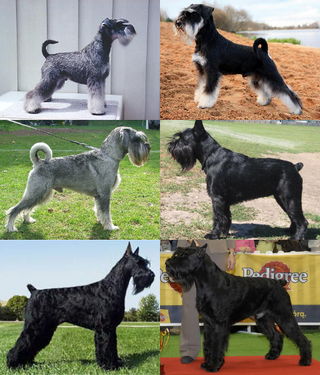
A Schnauzer is a dog breed type that originated in Germany from the 14th to 16th centuries. The term comes from the German word for "snout" and means colloquially "moustache", or "whiskered snout", because of the dog's distinctively bearded snout. Initially it was called Wire-Haired Pinscher, while Schnauzer was adopted in 1879.
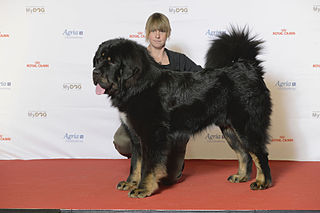
The Tibetan Mastiff is a large size Tibetan dog breed. Its double coat is medium to long, subject to climate, and found in a wide variety of colors, including solid black, black and tan, various shades of red and bluish-gray, and sometimes with white markings around neck, chest and legs.
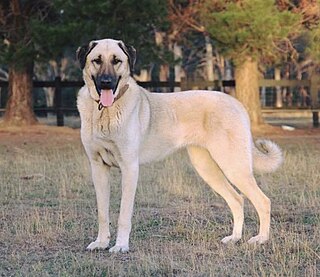
The Kangal Shepherd Dog is a traditional Turkish breed of large livestock guardian dog. The breed name derives from that of the town and district of Kangal in Sivas Province, the easternmost province of the Central Anatolia Region in central Turkey. The coat colour varies from pale fawn to wolf grey, always with a black mask.
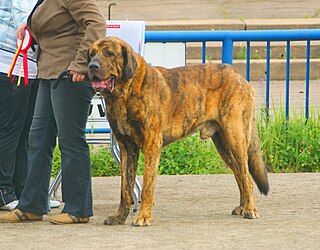
The Spanish Mastiff or Mastín Español is a breed of dog from Spain, originally bred to be a guard dog and whose specialized purpose is to be a livestock guardian dog protecting flocks and/or herds from wolves and other predators.

The Central Asian Shepherd Dog, also known as the Alabay, Alabai and Turkmen Wolf-Hound, is a livestock guardian dog breed. Traditionally, the breed was used for guarding sheep and goat herds, as well as to protect and for guard duty. In 1990, the State Agroindustrial Committee of Turkmenistan approved the standard of the Turkmen Wolf-Hound dog breed.

The Himalayan Sheepdog, known locally by various names including the Bhote, Bangara or Gaddi Kutta, and sometimes called the Himalayan Mastiff, is a breed of livestock guardian dog from the Himalayas, covering India. The Himalayan Sheepdog is found in the Himalayan foothills from eastern Nepal to Kashmir. The breed is primarily used as a livestock guardian dog, protecting flocks of yak and sheep from various predators, and as a property guardian dog; unusually for a livestock guardian, the breed is also used to assist with herding. The Himalayan Sheepdog is also used to assist in hunting.
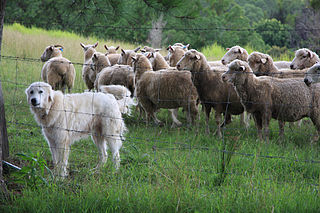
A livestock guardian dog (LGD) is a dog type bred for the purpose of protecting livestock from predators.

The Aksaray Malaklısı or Malaklı Karabaş is a breed of large livestock guardian dog, from the Aksaray Province in central Anatolia, part of Turkey. They are also known as the Turkish Mastiff or Anatolian Lion.
The Tibetan Kyi Apso is a medium to large sized breed of livestock guardian dog originating from Tibet and the Himalayas. It is considered an ancient and rare landrace, similar in appearance and stature to its relative, the Tibetan Mastiff.

The Cão de Gado Transmontano or Transmontano Mastiff is a breed of livestock guardian dog from Portugal. It originates in the historical province of Trás-os-Montes e Alto Douro in north-eastern Portugal, and is a rare breed confined mostly to this area.
Fatal dog attacks are human deaths caused by dogs. The study of fatal dog attacks can lead to prevention techniques which can help to reduce all dog bite injuries, not only fatalities. Dog bites and attacks can result in pain, bruising, wounds, bleeding, soft tissue injury, broken bones, loss of limbs, scalping, disfigurement, life-threatening injuries, and death.

The Assyrian Mastiff, was a landrace of dog found in Assyria. This dog was often used as a livestock guardian against predators, as well as for lion and wild horse-hunting. The modern Assyrian Shepherd may be a descendant of the Assyrian mastiff.





















